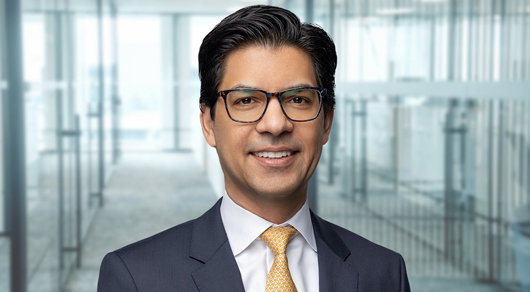This is the third in a series of articles in our special report on alternative investments in Canada. To see all the articles, click here.
Tariffs, economic uncertainty and an IPO market that has essentially stalled have so far dashed the high hopes many had for private equity in 2025. PE had been coming off something of a modest rebound in 2024, when exit activity accelerated. Yet distributions as a portion of net asset value—which are key for investors, of course—sagged to 11 per cent, the lowest rate in more than a decade, according to Bain & Company’s Global Private Equity Report 2025, published in March. Even though the industry has been anxious to make deals, Bain notes, “fund-raising lagged as limited partners kept a check on allocations in the face of prolonged asset holding periods.”
Ash Lawrence, head of AGF Capital Partners, AGF Management Ltd.’s diversified alternative business, says that so far in 2025, “PE hasn’t quite turned the corner from that subdued activity and low M&A and low IPO market. That also means there’s a lack of capital formation out there. Everyone appears to be on pause.”
But amidst a lingering malaise of stalled deals and uncertainties related to tariffs and to a restructuring of global supply chains, Lawrence says he sees a possibility for some green shoots to emerge during the second half of 2025 under either of two scenarios.

“If the tariff situation continues and materially impacts the U.S. and global economy and the PE world, that’s a perfect capital deployment environment,” he explains. “Companies are going to need to either shore up their finances or access capital to adjust their businesses to this new environment. While PE fundraising is slower today than historically, dry powder is at peak levels, with [alternatives data provider] Preqin data showing in excess of $1 trillion of dry powder in buyout strategies globally.”
On the flip side, Lawrence says, if the Trump administration softens its tariff focus in favour of concentrating on more stimulative tax policy and deregulation, the market will likely experience an increase in IPOs and M&A activity that could produce a thaw in private equity deals.
“I view these scenarios as two goalposts, and likely the real situation ends up somewhere between them,” he says. “But PE could see benefits in either scenario rather than the uncertain situation we find ourselves in today.”
PE managers are less reactive to headlines
For observers watching the recent rollercoaster ride and massive intraday trading of the public equity market, Lawrence says that the private equity market remains significantly calmer. That’s because PE managers tend to be less reactive to headlines and more motivated by hard facts.
“They’re more subdued in their valuations month to month or quarter to quarter,” he says. “I think there’s a lot of waiting to see how the situation in the U.S. plays out.”
Kim Furlong, chief executive officer of the Canadian Venture Capital & Private Equity Association (CVCA), also sees investors continuing to steadily deploy capital into private assets.

“While deal counts are down, overall dollars invested remain in line with historical Q1 activity,” she says. “This reflects transactions that were already in motion in late 2024. Despite the broader uncertainty in public markets, many investors still see private markets as the strongest avenue for long-term growth, which is a trend we expect to continue.”
That’s not to suggest that economic volatility hasn’t touched PE. The current macroeconomic environment is creating instability and making investors more cautious. (CVCA’s Q1 reports on venture capital and PE are due later this week, on May 14.) “Preliminary findings suggest that deal activity has slowed [as a result of volatility], even if total dollars invested have remained relatively stable so far,” Furlong says. “It’s likely that many of the transactions we will see reported for Q1 were initiated before recent developments took full effect. We expect to see the real impact of trade shifts and tariffs emerge later this year.”
IPOs are down, but not out?
Furlong also sees less optimism that 2025 will mark a rebound in IPO activity after a prolonged slowdown in 2023 and 2024. “The recent volatility in public markets, driven in part by tariff announcements, has tempered those expectations,” she says. “Many investors are delaying exits as they wait for better clarity on valuations and timing.”
Lawrence says he agrees that the IPO pipeline remains notably dry, but he sees more activity going on behind the scenes as stakeholders wait for uncertainties to pass.
“They’re putting that prepackaged, ready-to-go IPO on the shelf,” he says. “They’re doing all the prep work because they’re optimistic that the tariff situation will settle down and there will then be a turn to deregulation, tax policy, and ultimately the realization by the White House that if they really want GDP to increase and the economy to grow, they’re going to have to facilitate capital formation.”
PE should look for more nuanced opportunities
When considering the deployment of capital, Lawrence encourages investors to think less about PE and private credit as a monolithic investment class. “No one thinks of public equities as an amorphous block,” he says. “They think of global, emerging markets, the U.S., Canada, small- and mid-cap. With what’s going on in the market and what’s accessible to family offices and investors, they need to start thinking about private equity or private credit like that.”
Some PE is gravitating to more resilient markets, including areas like needed services. For example, Kensington Capital Partners, AGM’s PE affiliate, has been actively increasing its exposure to healthcare services, which tend to hold up through market cycles, especially in jurisdictions such as Canada where the government is the primary client.
Tariffs may also create some PE opportunities, Lawrence says, especially in areas such as manufacturing and industrials where increased automation can drive profitability. Kensington, for example, has been focusing on buying lower-mid-market or mid-market Canadian manufacturing.
“They’re creating value by bringing them up to date using robotics and automation, making them much more efficient and reducing costs,” Lawrence says. “I think this method of value creation is going to become more of a focus if you’re also offsetting potential tariff costs. We’re a big proponent of Canada at the moment, in terms of competition and availability of deals and price.”
Family offices remain committed to PE deployment
According to a December 2024 report by PwC, family offices have continued to increase exposure to PE, primarily because they’re less focused on deal-making to generate returns. “Contrary to the belief that family offices are homogeneous and typically created through a ‘cash event’ like a company sale, only 20% result from such events,” the report says. “The remaining 80% continue to draw wealth from active businesses. Most family office owners are entrepreneurs or entrepreneurial families, with only 5% owned by heirs.”
The report also says that PE firms consistently record higher investment inflows than outflows in terms of deal volume and value because of constant pressure to invest. Family offices, on the other hand, can “park” their capital in search of better opportunities.
Lawrence agrees, adding that family offices remain ready to deploy capital opportunistically in the face of broader capital shortages. In his experience, they continue to allocate roughly 30 to 35 per cent of their portfolios to PE. They also recognize a shortage of capital going into PE, co-investments and continuation funds—private equity vehicles that allow managers to extend the holding period of assets from an existing fund while providing the liquidity to allow existing investors to exit.
“Over the last 18 months, family offices have stepped in and filled the gap for capital to PE when institutions have slowed down to some degree,” he says.
Private credit performing well
AGF sees private credit performing well, although Lawrence says he sees some stress beneath the surface in large-cap sponsor-backed deals involving acquisitions by private equity that tend to be more aggressive. “We tend to like smaller, lower-mid-market areas where you’re lending to founders, entrepreneurs and families,” he says. “They’re typically operating businesses that have cash flow. Those kinds of segments in private credit, and certain asset-based solutions, are still performing well.”
Managers will matter more in the months ahead
The explosion in private markets for the earlier part of the past decade was marked by aggressive flows of capital and near-zero interest rates—an environment in which a burgeoning array of PE firms and their managers achieved success with relative ease. Yet that might not come as easily when PE markets thaw this time around and focus returns to the most resilient PE vehicles and the quality of their managers. “When capital finally starts flowing again, the winners will be funds with a clear, differentiated strategy and a record of consistent performance,” the Bain report says.
Some managers who are calmly sitting things out right now may possess just the right skill sets to reinflate PE markets, Lawrence says. Those skills include focusing on their existing portfolio of companies and creating operational efficiencies, adapting them to shifting global markets and being able to support them strategically.
“It’s really important for investors to understand that managers who can create that value within their companies are returning to the forefront,” he says. Furlong says she agrees. “Investors are taking a more cautious and selective approach,” she says. “The focus has shifted toward managing existing portfolios and evaluating new opportunities with greater scrutiny. The effects of tariffs and broader economic headwinds are being addressed on a case-by-case basis, and capital deployment is moving forward, but with increased discipline.”
The Canadian Family Offices newsletter comes out on Sundays and Wednesdays. If you are interested in stories about Canadian enterprising families, family offices and the professionals who work with them, but like your content aggregated, you can sign up for our free newsletter here.
Please visit here to see information about our standards of journalistic excellence.




